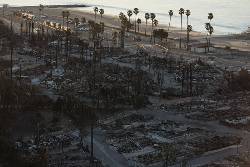LOS ANGELES (AP) — It has been more than a week since two massive fires forced tens of thousands of people to flee their homes in the Los Angeles area, and officials said Thursday residents won't be going home soon. As the search continues for human remains in the leveled neighborhoods, properties also face new dangers with burned slopes at risk of landslides and the charred debris laden with asbestos and other toxins.
More than 80,000 people are still under evacuation orders, and many do not know what, if anything, is left of their houses, apartments and possessions. Scores of people have gathered at checkpoints to plead with police and soldiers restricting access to their neighborhoods.
Officials said they understand their frustration, but they asked residents for patience as hazardous materials teams and cadaver dogs comb the sites block by block. They said it will be a week or more before people can go back.
“The properties have been damaged beyond belief,” Los Angeles County Public Works Director Mark Pestrella said at a briefing. “They are full of sediment, debris, silt and hazardous materials.”
Hillsides have become unstable behind some damaged homes, and a small landslide in Pacific Palisades this week sent debris into the streets, he added.
As firefighters continued to battle the two largest fires, which have killed 25 people and destroyed more than 12,000 structures, heartbroken families and burned-out business owners began to confront another monumental task: rebuilding what was lost.
The scale of the effort will be vast — the area scorched by the major fires is equal to three times the size of Manhattan. It is one of the most devastating natural disasters in Southern California history.
Recognizing the health risks, the county on Thursday prohibited any cleanup or removal of fire debris until a hazardous materials inspection is completed by government officials.
The city is also working on ensuring the region’s storm drainage system does not get clogged when rain begins to return in the coming weeks. Rain also poses the risk of mudslides.
The fires struck at a challenging time, with the city in the midst of a post-pandemic transition that has reordered work life and left many downtown buildings with high vacancy rates.
In addition, planning is underway to host the 2028 Olympics, and the region has perhaps the nation’s worst homelessness crisis, which had been Mayor Karen Bass’ priority before the fires broke out last week.
The government has not yet released damage estimates, but private firms expect losses to climb into the tens of billions of dollars. The blazes could become the costliest fire disaster in U.S. history.
Alex Rosewood and nearly her entire family in Altadena, northeast of Los Angeles, lost their homes — her father, whom she and her husband were living with, and her aunt, uncle and cousin next door.
Lost were the keepsakes of a lifetime: Rosewood's grandmother’s playing cards and unfinished quilt. Her wedding photos. Heirlooms from her grandfather, who served in the Navy. None of them could be saved as smoke turned the sky gray and her cousin’s house began to burn.
But Altadena remains home.
“We all plan to rebuild, for sure,” she said.
There will also be inevitable questions about whether it’s sensible to keep rebuilding in known high-risk areas, especially in an age of climate change.
What will the new neighborhoods look like? Will fire-resistant materials and designs be used? Are more and wider roads needed to allow swifter evacuations and easier access for fire engines during future infernos?
“It’s going to be a while before we can get in there and build anything,” said Michael Hricak, an adjunct professor of architecture at the University of Southern California, referring to the dangerous chemicals and rubble left behind.
As for new construction, “it’s not being tougher than Mother Nature. It's being somewhat respectful of Mother Nature and knowing what the challenges are.”
“Are we just inviting another problem down the road?” Hricak said.
The Northern California community of Paradise, where the state's deadliest wildfire killed 85 people in 2018, offers a glimpse into how painstaking and difficult recovery and rebuilding can be.
That fire destroyed about 11,000 homes — some 90% of the community's structures. About 3,200 homes and apartments have been rebuilt.
The town, which previously had a population of 26,000, has struggled under high construction costs, expensive insurance premiums and the uncertainty over money to be paid to people who lost homes by Pacific Gas & Electric, which was found liable for sparking the devastating blaze.
In Los Angeles — a city notorious for dense layers of bureaucracy and government red tape — Bass issued an executive order this week intended to clear the way for residents to rebuild quickly.
The federal government already has approved spending $100 million to remove paint, cleaners, asbestos, batteries and other household waste from the rubble before crews can begin clearing debris. Robert Fenton Jr., a regional administrator for the Federal Emergency Management Agency, called the plan a first step to getting people back in homes.
Elsewhere, the agency is handing out assistance to help people with short-term lodging.
Michele Baron and her daughter were among those who came to a recovery center in West Los Angeles to figure out how to get new birth certificates and Social Security cards.
Baron lost nearly everything when her Pacific Palisades apartment of 21 years burned to the ground. Her daughter made her way back to the property and salvaged a ring and pottery she made as a child.
Despite the trauma, the plan is to stay put.
“Now that I can go anywhere, I kind of don’t want to,” Baron said.
___
Associated Press writers Olga R. Rodriguez in San Francisco and Julie Watson in San Diego contributed to this report.
...


 Copyright © 1996 - 2025 CoreComm Internet Services, Inc. All Rights Reserved. | View our
Copyright © 1996 - 2025 CoreComm Internet Services, Inc. All Rights Reserved. | View our